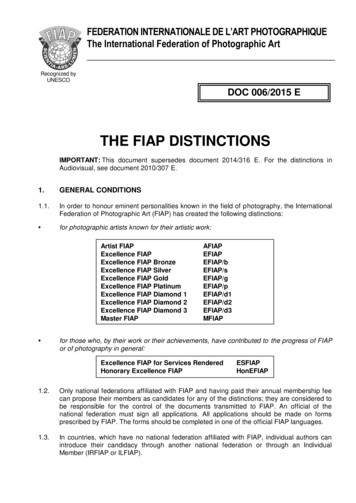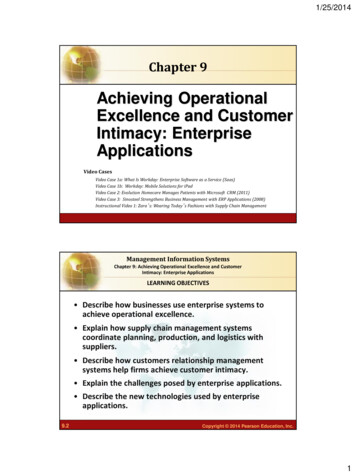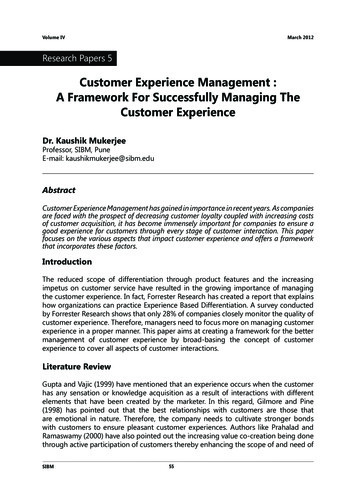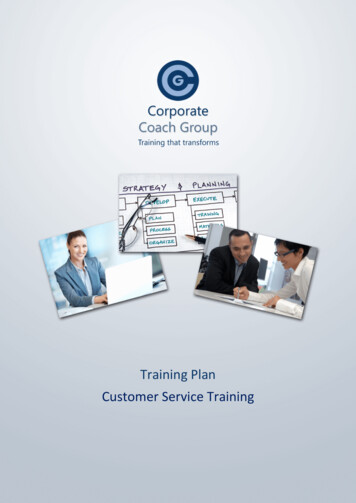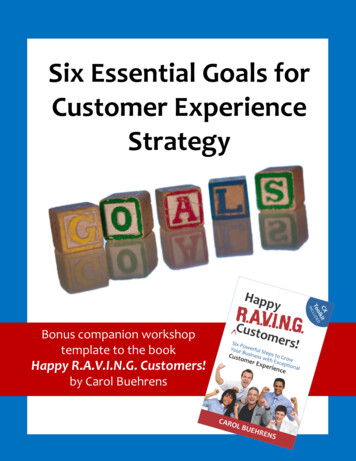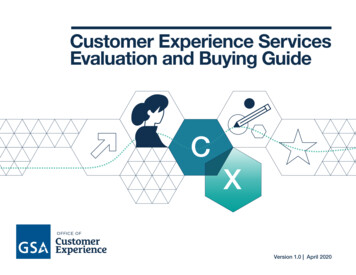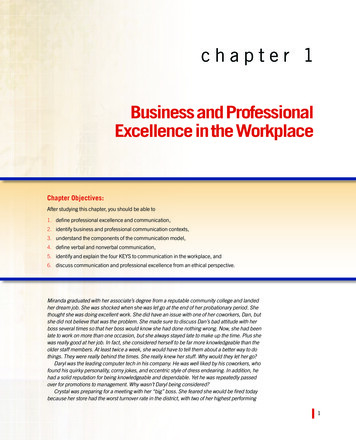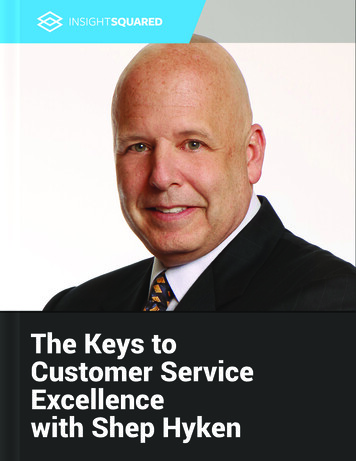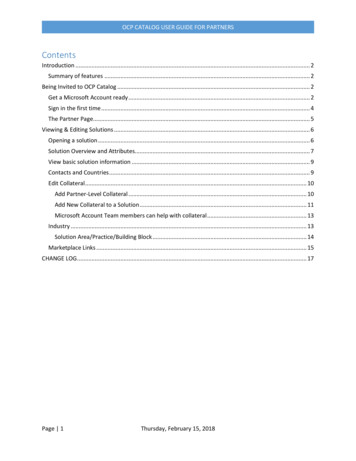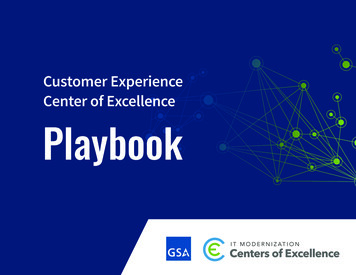
Transcription
Customer ExperienceCenter of ExcellencePlaybookCustomer Experience Playbook1
IntroductionCustomer Experience Playbook\\Customer Experience (CX) is not new; industry has been doing CX for a long time. Agenciesmay already be applying some or all of these best practices.What is new is the government’s central focus on CX with efforts such as the President’sManagement Agenda (PMA) for improving customer experience, the 21st Century IntegratedDigital Experience Act (IDEA), and the Federal Agency Customer Experience (FACE) Act tosupport CX practices. All of these efforts emphasize the government’s focus on improvingthe customer experience with accessing information and services.The Customer Experience Center of Excellence (CoE) works to develop a betterunderstanding of customer needs. The CX-CoE team is translating those findings into action.The team developed this 13-play Playbook for practitioners in all levels of governmentto establish or improve CX practices, and to foster a CX mindset within—and across—government agencies. While not every play will apply, they can help your agency get startedwith small, quick wins to build up expertise and gain confidence.Introduction continued 2
continued from previous page IntroductionCustomer Experience PlaybookThis playbook represents a synthesis of ideas gathered from interviewing several subjectmatter experts (SMEs) and leaders in CX and Human-Centered Design (HCD). This synthesis isaccording to relevant laws, policies, and guidance, including the updated OMB Circular A-11“Managing Customer Experience and Improving Service Delivery.” Whether you are just curiousabout CX, already dabbling in CX, or a professional CX practitioner, this playbook can offerinsight to enhance your agency’s CX presence.\\3
Key ConceptsCustomer Experience Playbook\\Throughout this document, we will refer to the following key concepts: Framework – A set of methodologies and approaches for delivering a product/service Human-Centered Design (HCD): A framework of processes that integrates a broad set of practices aroundunderstanding the needs, wants, and limitations of people interacting with a product/service, and that involvesthose people in the design process. It includes User-Centered Design (UCD), which deals with a person’sinteraction with a digital product. Methodologies – A set of rules governing the design effort, depending on the focus. Customer Experience (CX): A broad application of HCD to focus on the entire customer’s journey to achieve aparticular outcome, and identify their pain points and moments of delight to help prioritize design tasks. HCDencompasses other methods as needed. Service Design: Focuses on understanding and improving the quality of various interactions among users,employees, and any supporting staff behind the scenes to deliver a service. User Experience (UX)/User Interface (UI) Design: Related disciplines focusing respectively on the end-user’sexperience with specific digital products as part of their overall journey, and how the user gets information from,and interacts with specific applications and websites.Key Concepts continued 4
continued from previous page Key ConceptsCustomer Experience Playbook Approach – Outlines the specific process used to execute the design and development Design Thinking: General human-centered methodology of discover, design, prototype, test, implement, andrepeat. Intensely collaborative and iterative with a goal to develop something useful to end users. Data: Quantitative: Focused on quantifying the problem by way of generating numerical data or data thatcan be transformed into usable insights. It quantifies attitudes, opinions, behaviors, and other definedvariables and generalizes results from a larger sample population. Qualitative: Focused on establishing answers to the whys and hows of questions (unlike quantitative).Qualitative research involves asking participants about their experiences of things that happen intheir lives. It enables stakeholders to obtain insights into what it feels like to be another person and tounderstand the world as another experiences it. Findings are described in writing, rather than numbers. Operational: Measures the efficiency and effectiveness of an organization. Establish key performancemetrics such as key performance indicators (KPI), return on investment (ROI), quality assurance,marketing outcomes, employee satisfaction and customer satisfaction.\\5
Customer Experience PlaysPLAY1Choose Your Projects Strategically2Set Goals and Expectations3Identify Your Customers4Walk in Your Customer’s Shoes5Share and Act on Recommendations6Build a Service Catalog7Measure What Matters8Analyze and Publish Metrics9Reduce, Reuse, RecycleCustomer Experience Playbook\\6
Customer Experience PlaysPLAY10Get Your Bearings11Build a Partnership12Establish Your Foundation13Foster a Customer-Centric MindsetCustomer Experience Playbook\\7
PLAY1Customer Experience Playbook\\Choose Your Projects StrategicallyAs you start, find a range of projects that can benefit the most from CX methods.Look for those key customer challenges that have high visibility and high impact,but lack a key owner. You must be able to tackle these key challenges in smallsections so you can gain quick wins. Succeeding in the right initial projects will helpbuild trust in your capabilities and prove the value of CX at your agency.KEY QUESTIONS Which projects can show highvalue with the least effortand cost?CHECKLISTUse data to help identify these:Leadership’s high-visibility initiativesOpportunities to save money (e.g., consolidating similar surveys)Persistent customer issuesExisting metrics that could use a CX perspective (e.g., call-center data, operational KPI data, any customer/employee survey data)Look for projects that have high customer impact but require low effort to get traction (e.g., save customers time, make things easier,decrease employee burden).Start small and get quick wins to gain confidence, build trust, and generate momentum. Focus on one or two customer needs instead oftheir entire journey while you learn the techniques and develop expertise.Find projects that will have concrete results and measure their real change or progress over time.Play 1 continued 8
PLAY1continued from previous page Customer Experience PlaybookChoose Your Projects StrategicallyCHECKLISTData:Gather data about where the most customer interactions are concentrated.Find out which programs fund the most services.Obtain report of dollars currently spent on customer feedback and contact centers.Collect reports from contact centers of high-volume customer pain points.Create journey maps to identify high-impact customer pain points.Review existing key performance indicators (KPIs) and metrics.Tools:Review current CX government-wide resources and match to leadership goals.Prepare an impact/effort matrix for potential projects to find high-impact, low-effort options.Compare existing survey tools to identify opportunities to reduce duplication or overlap.Engagement:Find out from leaders which projects they prioritize.Understand customer engagement, team missions, and rules and regulations to identify partnerships opportunity.\\9
PLAY2Customer Experience Playbook\\Set Goals and ExpectationsMany of your stakeholders (and even your leadership) won’t know your CX’spurpose and methods. Explain your goals and manage expectations so you getthem to cooperate. Above all, make sure you listen: not just to your externalcustomers, but to your internal customers and stakeholders, too.KEY QUESTIONS Is the problem statement of yourresearch for the selected project clearto you and your stakeholders?CHECKLISTIdentify business owner(s) who will eventually take over the work.Identify success metrics.Define a specific customer goal or objective to drive the research. Work backwards from the goal to plan relevant research activities.Example: “We want a person to easily get a passport in seven days.”Determine where your stakeholders are largely focused: on technology, on business needs, on human resources, or on customer impact.Often, your project will start emphasizing one of these, and you may need to steer your stakeholders to rebalance these four elements.Assure stakeholders the purpose is not to audit current operations, but rather simply to listen, above all else, to customers/staff abouttheir experiences.Prepare a written agreement (e.g., Memorandum of Understanding (MOU), engagement letter) describing the goals and approach of theactivity, planned tasks and schedule, and level of participation for all parties.Maintain flexibility to adjust the plan as you learn more about the customer.Play 2 continued 10
PLAY2continued from previous page Customer Experience PlaybookSet Goals and ExpectationsCHECKLISTData:Identify the business owner(s) to gain access to data.Tools:Obtain a signed MOU, engagement letter, Interagency Agreement, or ad hoc/informal letter of agreement.Prepare a project work plan.Engagement:Get executive sponsorship.Talk to other stakeholders who may be affected by or interested in this project.Understand the constraints of stakeholders to build trust so that you can shift your approach as needed,without losing momentum.\\11
3PLAYCustomer Experience PlaybookIdentify Your CustomersBefore you can understand your customers, you have to know who they are.Then you can create personas representing your different customer types.You’ll use those personas as reference points to focus your thinking on yourcustomers as you develop solutions to meet their needs.KEY QUESTIONS Who are your customers (whether direct or indirect)? How well do you know them?CHECKLISTIdentify who your program/agency/cross-agency consortiumserves, which may include internal and external agencies, vendors,citizens, and employees.Document a persona (i.e., fact-based, yet fictional representation)for each customer you identify, capturing demographics,preferences, and activities related to your program/service anddesired outcomes. Show that you not only identify your customers,you actually understand them.Tools:Synthesize existing customer insights to determine whoyour customers are and what motivates them.Have workshops to select traits and have a picture (e.g.,photograph or illustration) that belong to each personato bring the persona to life.Engagement:Data:Collect data about visitors to the website, call center, socialmedia, but use the data cautiously—not all visitors to thesechannels are your customers.Identify unique characteristics that clearly distinguish specificcustomers from one another (e.g., programs they participate in,products they produce, etc.).Review existing customer segmentation data—a persona couldrepresent a defined segment.Interview a sample of the customers to gain insights intotheir values, needs, perspectives, and pain points.Involve a cross-functional group of stakeholders to getmany perspectives.\\12
PLAY4Customer Experience Playbook\\Walk in Your Customer’s ShoesOnce you’ve identified your customers and done your initial research, you cantruly understand your customers and their needs. You’ll use a variety of techniquesto gather qualitative and quantitative information about your customers’experiences from their point of view when they interact with your organization.KEY QUESTIONS What does a customer experience andfeel while accessing your program/serviceacross multiple channels?CHECKLISTDevelop a customer journey map for your program/service, including activities and touchpoints with your agency. Highlighting painpoints, points of delight, moments of truth, and the customer’s emotional state. Make sure the journey map addresses service recovery tounderstand what the customer’s experience when something happens that they don’t expect.To build further empathy and understand the entire customer experience, consider also developing a broader journey map thatdescribes your customer’s overall objective, of which your program may be just one step. The broader journey may even include otheragencies. For example, the journey a new business owner takes to obtain a permit is just one piece of a broader journey that includesobtaining licenses, finding and building out space, having inspections, getting insurance, hiring employees, etc.For a deeper dive, consider blending the journey map with your business process map to demonstrate the full design required to deliverthe service depicted in the journey.Review existing customer feedback, both qualitative (e.g., surveys with open text/seeking opinions, interviews, roundtables, etc.), andquantitative (e.g., surveys yes/no, scaled questions, website analytics) to learn your customers’ direct and indirect preferences.Document your work at each step: what you did and how you did it, both for future efforts and to share knowledge.Gather and document lessons learned after each activity to capture what went well and what needs work. You can use these for newactivities and future projects.Play 4 continued 13
PLAY4continued from previous page Customer Experience PlaybookWalk in Your Customer’s ShoesCHECKLISTData:Review existing customer feedback data: social listening reports, contact center trends.Capture information about the customer journey: touchpoints, experiences, and technology used.Tools:Select from various methods for working with customers and stakeholders to get feedback, develop options, and setpriorities, described by GSA 18F.Conduct qualitative research: ethnographic interviews, customer roundtables, town halls, listening tours, surveys,and journey mapping.Prepare and circulate workshop reports to describe the activities and outcomes.Engagement:Provide access to—and build relationships with—your customers in person.Work with leadership and customer-facing staff to identify candidate locations and individuals to interview.Get buy-in from local offices.Hold workshops with stakeholders to keep them informed and to help prioritize upcoming activities.\\14
PLAY5Customer Experience Playbook\\Share and Act on RecommendationsAfter you’ve done your research, you’ll need to synthesize thedata, analyze your findings, highlight insights, and prioritizerecommendations. You must be able to effectively communicate yourwork so your stakeholders and leaders understand the impact of yourfindings and proposed solutions.KEY QUESTIONS How can the customer experience improve? How will you share your findings with a broader audienceto gain visibility and implement recommendations?CHECKLISTForm insights and recommendations for improving customer experience using various methods:Develop tools that can help solve customer problems (e.g., write the customer’s name on a cup to personalize the experience; givecustomers a handout showing their customer journey at the beginning to reduce their anxiety; hire the right staff to perform uniquefunctions, train staff for specific skills, etc.).Deploy technology that addresses customer preferences (e.g., va.gov uses a single portal so customers can get multiple veteran benefits).Establish engagement opportunities for continual customer feedback (e.g., local community boards that solicit comments directly fromcustomers, roundtable discussions).Advocate for policy changes that can remove barriers to or further enhance good customer experience.Publish insights and recommendations along with your methodology and approach for distribution to agency leadership and/or the public.Contribute articles to blogs/newsletters about your activities to spread the word and raise visibility.Where possible, keep the people you interviewed aware of your findings to close the loop—delivering a good customer experience for thosewho helped with your research.Brief key stakeholders on actionable recommendations they can take to improve customer experience.Play 5 continued 15
5PLAYcontinued from previous page Customer Experience PlaybookShare and Act on RecommendationsCHECKLISTUnderstand the capacity of stakeholders for implementing recommendations.Work with stakeholders to prioritize recommendations.Plan to implement changes.Data:Review interview notes and evaluate results from prioritization activities (e.g., card sorting exercise).Tools:Use techniques such as mind mapping to synthesize raw notes and identify key insights.Write stories that represent different customer experiences to help people better relate to the findings.Prepare a brief to share recommendations with stakeholders.Use methods like an impact/effort matrix to prioritize implementation opportunities.Engagement:Meet routinely with the team(s) responsible for implementing recommendations to share insights and supportprioritization of activities.Develop relationships with content channel owners to publish your materials, artifacts, and findings with stakeholdersand customers along the way.\\16
6PLAYCustomer Experience PlaybookBuild a Service CatalogA successful CX engagement in an organization can often lead toothers—but only if people know what you’ve done, what you cando, and how your CX expertise can help them. Your goal is to raiseawareness, capability, and demand for CX in your organization.KEY QUESTIONS Do potential partners know the work yourteam can support?CHECKLISTIdentify the CX services your team can support, such as workshops,ethnographic research, survey design, journey mapping, Voice ofthe Customer practice, human-centered design, service design,consultation, customer data synthesis, etc.Make the offerings flexible enough to meet your clients’ uniquedemands, but standard enough so you can offer them consistently.Tools:Create repeatable processes and products that youcan provide in customer experience engagements.Prepare templates for frequently used activities.Engagement:Publish the internal CX standard operating procedures (SOPs) togive to prospective clients and leadership.Meet with department heads and suggest areas that customerexperience practices can help with their business objectives.Data:Catalog prior and ongoing CX efforts to date.Evaluate your staff’s skills and project experience.Share the standard operating procedures (SOPs)manual as you assemble it with your stakeholders.Get feedback from clients regarding work your teamhas performed.\\17
PLAY7Customer Experience Playbook\\Measure What MattersThe right analytics are meaningful, tell a coherent story, and leadto key insights and better decisions. Here’s how to make sure thatthe metrics you develop lead your organization to quantifiable,sustainable improvements.KEY QUESTIONS Are you asking customers the right questions? Are you collecting the right metrics in the right way? Are your efforts making a difference for the customer?CHECKLISTReview your goals and work backwards to identify metrics that measure progress towards those goals. For inspiration, look at:The moments that matter in the customer’s journey to help validate the impact of any efforts to improve the customer experienceaffecting those moments.Failure demand, such as spikes in calls to the contact center, where customers have self-identified pain points in their experience.Your agency’s defined performance metrics and/or Cross-Agency Priority goals.The OMB A-11 Circular section 280 for recommended customer experience metrics.Make the metric relevant— tie it to a specific customer transaction, not just the customer’s relationship with your agency.Adjust the metric to keep data unbiased. For example, customer satisfaction is influenced by the nature of the activity—paying taxes willhave a lower satisfaction score than visiting national parks—so ask questions about the process instead of the outcome (e.g., Did youunderstand the requirements? How easy was the process? Were agents pleasant/helpful? Were issues resolved soon enough? Did youunderstand the factors that affected your outcome? Did you trust the individuals you worked with?).Keep the metric simple so it can be easily understood, tell a clear story, and enable decision makers to gather what actions can be takento reach the corresponding goal. To stay effective, keep surveys simple—ask few questions and ask straightforward questions.Play 7 continued 18
7PLAYcontinued from previous page Customer Experience Playbook\\Measure What MattersCHECKLISTAssign an owner to each metric. Without someone accountable for acting on it, the metric is worthless.Clarify the actions(s) that the agency can take to improve based on the metric’s outcome (e.g., an increase or decrease in value). Don’t measuresomething if you can’t change the outcome.Decide how often the metric will be reviewed. The more real time the metric, the more effective any actions related to it will be.To assure trust in the data, capture reference information about each metric, such as when last updated, from which system(s), how it wascalculated, etc.Find the best source for your metric:Qualitative methods like open text surveys and social media posts.Quantitative methods like website analytics and contact center data.For each metric, establish a baseline to compare to future results to understand how your initiatives are affecting customer experience.Identify a way to check the pulse to understand how initiatives you undertake to improve customer experience impacts the customer satisfaction.Find opportunities to integrate customer feedback data from other channels, programs, and business areas to provide a more rounded view of thecustomer experience (i.e., Voice of the Customer).Data:Review contact center data for customer pain points.Review existing data sources for customer feedback.Play 7 continued 19
PLAY7continued from previous page Customer Experience PlaybookMeasure What MattersCHECKLISTTools:Review the Paperwork Reduction Act (PRA) guidelines before suggesting new surveys.Review the customer journey map.Implement a tool to integrate feedback mechanisms and provide a central reporting approach for the Voice of the Customer results.Review the OMB circular A-11 section 280 for the questions different services should ask about customer experience (see Resources:Understand CX/Design Standards).Use general surveys GSA provides to jump start your feedback collection.Engagement:Develop relationships with those responsible for customer feedback across different channels to get their buy-in and support.Hold workshops with feedback channel owners and business intelligence leads to improve data collection agency-wide.\\20
8PLAYCustomer Experience PlaybookAnalyze and Publish MetricsEven the best-crafted analytics have little value if they don’t reachthe right people. Make sure your analytics are used to make datadriven decisions. Give them to stakeholders and decision makerswith the context they need to understand them.KEY QUESTIONS With whom are you sharing your metrics to highlightsuccesses and drive business decisions? How are you sharing your metrics? How transparent are your metrics?CHECKLISTAnalyze metrics for insights and success stories, however incremental, to share with agency leadership and build momentum.Share the metrics routinely with stakeholders and decision makers to prioritize work and drive changes towards meeting stated goals.Use success stories and quick wins, framed with customer-centric achievements, as a way to gain support for more investment.Data:Obtain data from various channels pertaining to the customer experience, including website analytics, survey data, contact centerdata, social media data.Tools:Develop a dashboard for access to important metrics and share it with decision makers and possibly the public.Publish interesting results in agency blogs and newsletters.Engagement:Present metrics to decision makers to provide more context for business prioritization.Use measurement as an opportunity to maintain contact with the business.\\21
PLAY9Customer Experience PlaybookReduce, Reuse, RecycleMaintain your analytics and reporting so they stay relevant while businessrequirements, environmental factors, and customer expectations change. If yourorganization isn’t regularly using your reporting to make content improvements,you need to re-examine your reports.KEY QUESTIONS How useful are the metrics? Are any adjustments needed?CHECKLISTEvaluate existing qualitative (e.g., surveys) and quantitative(e.g., website metrics) measures and methods for usefulness.Each metric should be:Choose the disposition for each metric:Keep metrics that are still useful,Goal-oriented to provide a target,Discard metrics that are not useful or no longer needed,Relevant to a specific customer transaction,Modify metrics that can be improved, andUnbiased by the outcome of a customer’s transaction,Add metrics that are missing.Simple to understand and act on,Owned by a responsible business owner,Actionable so undesired outcomes can be corrected, andTimely with an appropriate frequency to make effectivedecisions.Data:Review data from various channels for the customer experience,including website analytics, survey data, contact center data, andsocial media data.Tools:Poll decision makers to learn which metrics they find useful.Form a working group to routinely evaluate the metrics foreffectiveness, comply with government standards, and alignwith industry trends.Engagement:Hold workshops with program and agency leadership, channelowners, and other stakeholders to evaluate the metrics.\\22
PLAY10Customer Experience Playbook\\Get Your BearingsAgencies in both the public and private sectors continually innovatehow they identify and solve CX challenges. Stay abreast of CXinnovations and best practices so your organization can use themto ensure that you are doing everything you can to deliver the bestpossible customer experiences.KEY QUESTIONS To what extent is your organization able to support CXpractices currently? How do they compare with industry best practices? Where can you start?CHECKLISTAssess what metrics are currently captured to measure CX, how they are captured, and the overall strategy for measuring CX.Assess the level of leadership support for CX activities.Assess the governance for CX activities.Assess training and incentives provided to employees inside and outside government to foster a CX culture.Assess the extent of customer research performed to evaluate the customer experience for programs and services.Assess the capacity to implement service design concepts, including staffing, business processes, and technology.Learn from the experts—borrow from other agencies and use industry best practices to determine what best suits your agency.Play 10 continued 23
PLAY10continued from previous page Customer Experience PlaybookGet Your BearingsCHECKLISTData:Engagement:Learn from public-sector agencies with CX expertise:GSA’s Centers of Excellence,GSA’s Office of Customer Experience,Gather input from program managers, data analytics teams,communications teams on existing measures, collectionmethods, and infrastructure.Gather input from leadership on staffing, resources, priorities,and strategy.Office of Personnel Management’s The Lab @OPM, andDepartment of Veterans Affairs (VA) Veterans ExperienceOffice (VEO), etc.Review customer feedback data already being collected.Review and study CX practices from industry leaders.Review studies and reports from leading research andconsulting firms.Tools:Review the OMB Circular A-11 section 280 for guidance on whatto measure.Complete the Office of Management and Budget (OMB) CXMaturity Assessment.Gather input from human resources on available training andincentives.Gather input from program managers on current techniquesfor gathering customer insights.\\24
PLAY11Customer Experience Playbook\\Build a PartnershipBy being an effective advocate for CX capabilities, you canturn clients into CX evangelists, identify more high-impactprojects, and raise awareness of both CX’s benefits and yourorganization’s ability to use CX to solve customer challenges.KEY QUESTIONS Whom can you partner with to develop a CX culture and presence? Do you have a common language and share a common vision?CHECKLISTTalk frequently with leadership to get buy-in. Cite the PMA, public- and private-sector case studies, and real data to show actual benefits.Build relationships with your internal and external stakeholders to increase integration and prevent isolation.Collaborate, don’t dictate—make allies, not demands.Use the same language (or decide together on the language) to ensure a common understanding and spur progress towards meetingcustomer needs.Engage continually with employees because they can be a great source of ideas and insights.Focusing on employee experience will lead to delivering better customer experiences.Involve all the stakeholders in the co-creation process, including skeptics and dissenters—give them a stake in the game.Find other employees with a shared passion for focusing on customer experience.Meet with them regularly to discuss ideas and form a mentor network.Play 11 continued 25
PLAY11continued from previous page Customer Experience PlaybookBuild a PartnershipCHECKLISTData:Collect a list of key stakeholders.Gather case studies from CX leaders.Review glossaries, information about the program(s) and service(s) you’ll be addressing, andinformation about how customers talk about these.Tools:Hold workshops to introduce CX and establish common language.Research the return on investment (ROI) for CX efforts.Engagement:Build relationships with the technology owners, communications channel owners, program/service owners, and contact center owners.\\26
PLAY12Customer Experience Playbook\\Establish Your FoundationLearn how to develop and maintain CX capabilities in your agency.By effectively communicating the value of CX across the enterprise,you can engage natural allies—people who already have a CXmindset, even if they don’t have a name for it—and support
Customer Experience Playbook 4 Key Concepts Throughout this document, we will refer to the following key concepts: Framework – A set of methodologies and approaches for delivering a product/service Human-Centered Design (HCD): A framework of processes that integrates a broad set of practices around un
